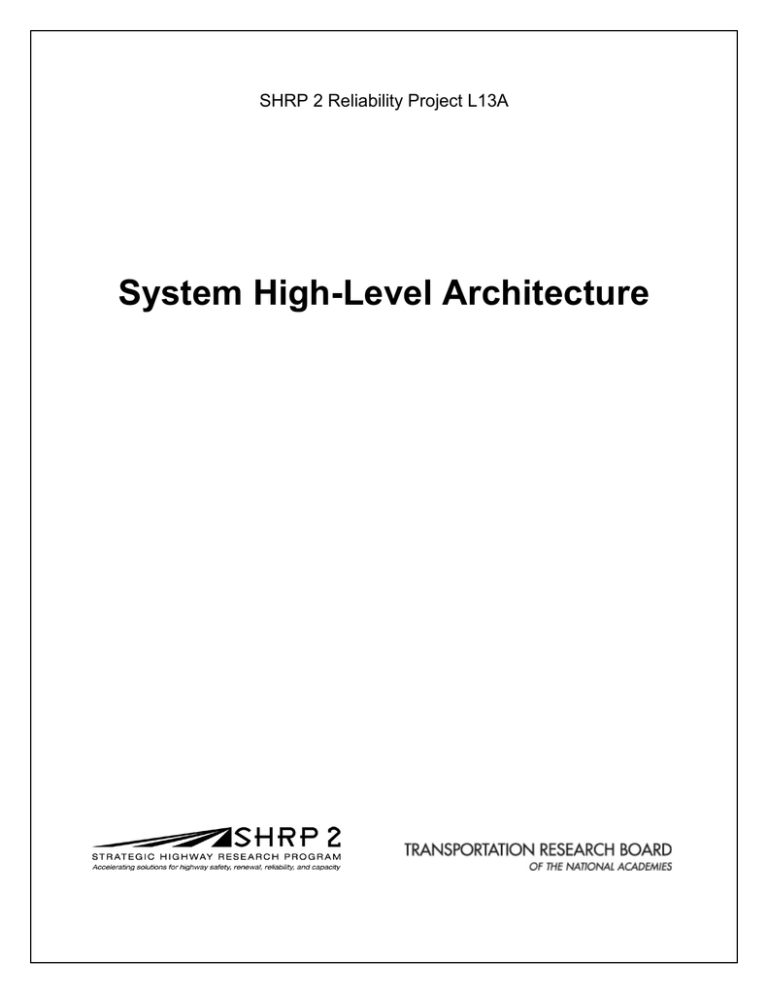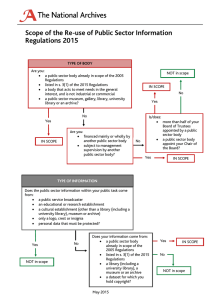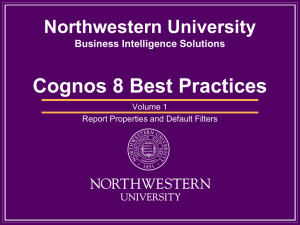
SHRP 2 Reliability Project L13A
System High-Level Architecture
SHRP 2 Reliability Project L13A
System High-Level Architecture
Prepared by
Iteris
TRANSPORTATION RESEARCH BOARD
Washington, D.C.
2015
www.TRB.org
© 2015 National Academy of Sciences. All rights reserved.
ACKNOWLEDGMENT
This work was sponsored by the Federal Highway Administration in cooperation with the
American Association of State Highway and Transportation Officials. It was conducted in the
second Strategic Highway Research Program, which is administered by the Transportation
Research Board of the National Academies.
COPYRIGHT INFORMATION
Authors herein are responsible for the authenticity of their materials and for obtaining written
permissions from publishers or persons who own the copyright to any previously published or
copyrighted material used herein.
The second Strategic Highway Research Program grants permission to reproduce material in this
publication for classroom and not-for-profit purposes. Permission is given with the
understanding that none of the material will be used to imply TRB, AASHTO, or FHWA
endorsement of a particular product, method, or practice. It is expected that those reproducing
material in this document for educational and not-for-profit purposes will give appropriate
acknowledgment of the source of any reprinted or reproduced material. For other uses of the
material, request permission from SHRP 2.
NOTICE
The project that is the subject of this document was a part of the second Strategic Highway
Research Program, conducted by the Transportation Research Board with the approval of the
Governing Board of the National Research Council.
The Transportation Research Board of the National Academies, the National Research Council,
and the sponsors of the second Strategic Highway Research Program do not endorse products or
manufacturers. Trade or manufacturers’ names appear herein solely because they are considered
essential to the object of the report.
DISCLAIMER
The opinions and conclusions expressed or implied in this document are those of the researchers
who performed the research. They are not necessarily those of the second Strategic Highway
Research Program, the Transportation Research Board, the National Research Council, or the
program sponsors. The information contained in this document was taken directly from the
submission of the authors. This material has not been edited by the Transportation Research
Board.
SPECIAL NOTE: This document IS NOT an official publication of the second Strategic
Highway Research Program, the Transportation Research Board, the National Research Council,
or the National Academies.
The National Academy of Sciences is a private, nonprofit, self-perpetuating society of distinguished
scholars engaged in scientific and engineering research, dedicated to the furtherance of science and
technology and to their use for the general welfare. On the authority of the charter granted to it by
Congress in 1863, the Academy has a mandate that requires it to advise the federal government on
scientific and technical matters. Dr. Ralph J. Cicerone is president of the National Academy of Sciences.
The National Academy of Engineering was established in 1964, under the charter of the National
Academy of Sciences, as a parallel organization of outstanding engineers. It is autonomous in its
administration and in the selection of its members, sharing with the National Academy of Sciences the
responsibility for advising the federal government. The National Academy of Engineering also sponsors
engineering programs aimed at meeting national needs, encourages education and research, and
recognizes the superior achievements of engineers. Dr. C. D. (Dan) Mote, Jr., is president of the National
Academy of Engineering.
The Institute of Medicine was established in 1970 by the National Academy of Sciences to secure the
services of eminent members of appropriate professions in the examination of policy matters pertaining to
the health of the public. The Institute acts under the responsibility given to the National Academy of
Sciences by its congressional charter to be an adviser to the federal government and, upon its own
initiative, to identify issues of medical care, research, and education. Dr. Victor J. Dzau is president of the
Institute of Medicine.
The National Research Council was organized by the National Academy of Sciences in 1916 to
associate the broad community of science and technology with the Academy’s purposes of furthering
knowledge and advising the federal government. Functioning in accordance with general policies
determined by the Academy, the Council has become the principal operating agency of both the National
Academy of Sciences and the National Academy of Engineering in providing services to the government,
the public, and the scientific and engineering communities. The Council is administered jointly by both
Academies and the Institute of Medicine. Dr. Ralph J. Cicerone and Dr. C.D. (Dan) Mote, Jr., are chair
and vice chair, respectively, of the National Research Council.
The Transportation Research Board is one of six major divisions of the National Research Council.
The mission of the Transportation Research Board is to provide leadership in transportation innovation
and progress through research and information exchange, conducted within a setting that is objective,
interdisciplinary, and multimodal. The Board’s varied activities annually engage about 7,000 engineers,
scientists, and other transportation researchers and practitioners from the public and private sectors and
academia, all of whom contribute their expertise in the public interest. The program is supported by state
transportation departments, federal agencies including the component administrations of the U.S.
Department of Transportation, and other organizations and individuals interested in the development of
transportation. www.TRB.org
www.national-academies.org
Table of Contents
1.1
Introduction .......................................................................................................................... 2
1.2
Amazon Web Services (AWS) ............................................................................................. 3
1.3
WordPress ............................................................................................................................ 4
1.3.1
Themes........................................................................................................................... 4
1.3.2
Plugins ........................................................................................................................... 5
1.4
MySQL Database ................................................................................................................. 5
1.5
Solr Search Engine Server.................................................................................................... 5
1.6
S2A Server ........................................................................................................................... 6
1.7
Tripwire ................................................................................................................................ 8
1
1.1
INTRODUCTION
This document outlines all the components of the SHRP 2 Archive System. Most of the content
included in this document is a part of Chapter 7 of the final L13A report. System and other technical details
provided in Chapter 7 of the final report were reviewed and revised in this document to reflect the most upto-date details.
SHRP 2 Archive System consists of the following components:
●
●
●
●
●
●
●
●
Amazon Web Services (AWS);
Apache HTTP server;
WordPress system with specific SHRP 2 plugins and themes;
MySQL database;
Tomcat application server;
Solr search engine;
S2A Server; and
Tripwire.
These components are interconnected as shown in Figure 1-1. The data flow between these
components is depicted in Figure 1-2.
Figure 1-1: Components of SHRP 2 Archive.
2
Figure 1-2: Data Flow Diagram for the L13A Data Archive.
The following sections provide detailed information on each of the above listed components.
1.2
AMAZON WEB SERVICES (AWS)
AWS is a bundle of remote computing services that provides a cloud-computing platform that is
offered over the Internet. Both the L13 report and L13A Iteris team’s assessments indicated that the cloudbased service is a viable solution for hosting the Archive. From the Iteris team’s point of view, the proposed
L13 architecture (See Section 3.1.10 of the L13A report) was slightly outdated. To that end, the Iteris team
modified the proposed architecture and leveraged the extensive cloud-based services Amazon provides to
the public. We deployed the Archive system on a bundle consisting of the following components:
●
●
Amazon Elastic Compute Cloud (EC2). EC2 provides virtual servers and is delivered on the
CentOS (RHEL) operating system. EC2 manages the data and information via Elastic Block
Storage (EBS). EBS is a volume-based storage that has a separate life span and can be attached
to any instance. EBS module size is 200 GB and can be resized. For now the team has used the
medium M3 instance for the EC2 module. It should be noted that in our design we have not
implemented a hot standby instance as a backup for cases when the operation of the EC2
module fails. Amazon guarantees uptime of more than 99%. In case of any potential failure the
admin team can set up another instance in a couple of hours.
Amazon Relational Database Service (RDS). Database administration (e.g., configuration,
backup, monitoring resource consumption, etc.) is an expensive and error-prone task. The
purpose of this module is to provide a relational database service via amazon cloud that helps
users save money and avoid errors. RDS supports three popular relational databases, i.e.,
MySQL, SQL Server, and Oracle. The Archive utilizes MySQL for managing its database
3
system. As of September 2014, the size of the database was 500GB. The service is elastic.
Therefore scaling up the storage is very easy.
1.3
WORDPRESS
WordPress is one of the most popular open source content management and blogging systems
available. WordPress was selected as the core Content Management System (CMS) of the Archive after a
thorough assessment of various Commercial Off-the-Shelf (COTS) CMSs (see Section 3.5.4 of the L13A
report for more information).
WordPress requires a web server with PHP support, a URL rewriting facility, and an instance of
MySQL. The Archive system uses Apache as the HTTP server. Apache is a preferred option developers
normally implement with WordPress because it provides PHP interpretation and URL rewriting.
1.3.1
Themes
The WordPress theme is the face and graphical aspect of the website which encompasses the entire
user experience. Therefore, the appearance of the user interface is built based on a theme. A theme is a
bundle of template files (PHP files to provide logic and structure), CSS files (to keep the style), images, and
JavaScripts.
There are many WordPress theme resources available that can be used directly or customized. The
SHRP 2 Archive theme is a child theme of WordPress’ Twentyeleven general theme. The SHRP 2 Archive
theme was customized for the Archive user interface.
1.3.1.1 Key Open Source JavaScript Libraries Used in the Archive
JavaScript works within WordPress. It can be used within WordPress template files in WordPress
Themes or Child Themes. As recommended by the L13 report, the Iteris team aimed to use open source
libraries as much as possible. Table 1-1 summarizes the list of open source JavaScript libraries used to
deliver some of the core functionalities of the Archive system.
Table 1-1: List of open source JavaScript Libraries
JavaScript
Recline
Slickgrid
Highchart
Leaflet
Description
Library to build data applications. It can be
integrated with Leaflet, Slickgrid, and Highcharts.
This library was used a platform that delivers the
visualization functionalities on the Data tab located
on top of the data set pages.
Grid/spreadsheet view of the data sets.
Data set plots and graphs.
Interactive maps features, i.e., markers, overlapping
marker spiderfier. Map tiles based on
OpenStreetMap.
4
1.3.2
Plugins
In WordPress, a plugin is a PHP file that provides specific functionality to a website. It allows the
theme to achieve a certain objective and help users tailor the website for their specific needs. Table 1-2
shows the list of plugins used for the Archive.
Table 1-2: List of plugins used in the Archive
Plugin
Attributes Plugin
Custom Email
L13a Ingestion
L13A WP-Admin Restriction Mode
Meteor Slides
S2 Comment Form
SHRP 2 Custom Meta
SHRP 2 Workflow
Solr for WordPress
Theme My Login
1.4
Description
A plugin that is used to handle inappropriate
content, ratings, and such. This feature was
implemented into the system but is not being used.
Sends custom email from SHRP 2 Archive plugins,
and adds a custom registration email
Implements the custom file ingestion process for the
L13a reliability data archive.
Hides the WordPress Admin banner on top of the
site.
Easily creates responsive slideshows with
WordPress that are mobile friendly and simple to
customize. In the SHRP 2 Archive system, the
admin has the ability to insert a slideshow at the
homepage.
A plugin to add custom fields to the comment form.
This plug-in defines and enables custom metadata
fields.
Enables administrators to manage artifacts in the
SHRP 2 Archive.
Provides access to the indexed content of the Solr
search engine. Also, indexes existing Wordpress
pages.
Themes the WordPress login, registration and
forgot password pages according to your theme.
MYSQL DATABASE
For most applications WordPress normally deals with the database by itself in such a way that the
developer does not need to worry about the structure and the design of the database. The archive reads and
writes data to tables in the MySQL database. Archive functionality is supported in MySQL by modifying
existing WordPress tables and adding new tables. Section 7.3.1 and Section 7.3.2 of the L13A report review
the native WordPress tables and the SHRP 2-specific tables in more detail.
Please note the Archive stores data sets in two formats:
●
●
1.5
Data sets (CSV files) uploaded by users as part of the ingestion process are stored in the file
system.
In the ingestion process, the Archive stores the data sets in indexed database tables, which are
used for visualizing and filtering data.
SOLR SEARCH ENGINE SERVER
Solr is an open source enterprise search engine project sponsored by the Apache Software
Foundation. Solr provides keyword search functionality for the Archive. Solr is written in Java and runs as
5
a standalone full-text search server within a servlet container such as Tomcat. Solr uses the Apache Lucene
Java search library at its core for full-text indexing and search, and has REST-like HTTP/XML and
JavaScript Object Notation (JSON) APIs that make it easy to use from virtually any programming language
(Apache Lucene 2014). The Archive’s Solr engine has been installed on Apache Tomcat. Solr indexes any
artifact and metadata being uploaded into the Archive before they become available on the Archive.
1.6
S2A SERVER
S2A server is a back-end server application written in Java that manages artifact workflow and
processing states in the Archive. Depending on the type, an artifact goes through different back-end
processes. The workflow controls various processing paths that an artifact goes through, from the time it is
uploaded into the Archive till the moment it becomes available in (or gets deleted from) the Archive. S2A
core functionalities are listed in Section 5.2 of the L13A report (Step 4. back-end processing).
There are three state variables by which the status of an artifact in the Archive is defined. These
variables are stored in wp_posts table. Table 1-3 summarizes the state variables.
s2_wf_state – Shows an artifact’s workflow state. Figure 1-3 depicts the various workflow states.
s2_proc_state – Indicates the back-end processing status of an artifacts. See Section 5.2 of the
L13A report (Step 4. back-end processing) for more information.
s2_proc_msg – Provides processing outcomes in a message for the Creator. The message is
displayed on ‘My Artifact’ list located on ‘My Profile’ page.
Table 1-3: State Variables
State Variables
s2_wf_state
Description
Workflow approval state
Values
0=Ingest, the artifact is in the ingestion process but
not yet submitted. This is the default state for a new
artifact.
3=Unprocessed
● Triggered by: Submit button pressed in Step 4 of
the ingestion process
2=Processing
● Triggered by: admin reviews and approves
1=Published, available for public use
● Triggered by: s2a server completes processing
-1=Pre-trash
● Triggered by: admin action, sending to bin state
-3=Trash
● Triggered by: s2a-server moves artifact from
Gulag to Bin state
s2_proc_state
Processing state
-4=Processing error (validation, loading, or indexing)
● Triggered by: s2a server (see s2_proc_state and
s2_proc_msg for details)
-1=error
6
State Variables
Description
Values
0=unprocessed (default)
1=validating
2=validation failed (see s2_proc_msg)
3=loading
4=load failed (see s2_proc_msg)
5=indexing
6=indexing failed (see s2_proc_msg)
s2_proc_msg
Message for users from
artifact processing
10=complete
“Data set ingestion finished.”
“Could not parse XXX fields. Optimizing table.”
“Calculating column extents.”
“Internal error: unknown column type.”
“Failed to load.”
The archive uses the concept of a Finite State Machine to manage the state of artifacts as they move
through processing steps (Figure 1-3). The states for each artifact are stored in the database table
‘wp_posts’. The columns ‘s2_wf_state’ and ‘s2_proc_state’ in this table store the workflow and processing
states for each artifact, respectively. The workflow column (s2_wf_state) corresponds to the WorkflowState
Java class in the S2A server. The processing state column (s2_proc_state) corresponds with the
ProcessingState Java class in the S2A server. Figure 1-3 shows workflow states and the associated
administrative (or processing) steps that cause the artifact to transition to a new state. The processing state
is determined by the backend processing (S2A) of each artifact and may be one of the following: error,
unprocessed, validating, validate_failed, loading, loading_failed, indexing, indexing failed, complete.
Published artifacts have a processing state of complete (see the Java code for actual values). For
administrative purposes, it may sometimes be useful to directly manipulate the states of artifacts via SQL
update statements.
7
Figure 1-3: The Archive Processing Finite State Diagram
1.7
TRIPWIRE
Tripwire is an intrusion detection system that also provides integrity assurance, change
management, and policy compliance. Tripwire can be used to detect unexpected changes to files. Tripwire
scans take about 30 seconds on the L13A Archive System and generate reports showing changes to files.
8






![University Archive Rules and Visitor Book [Word]](http://s3.studylib.net/store/data/007461955_1-a66c84ca7724fc8dd4fb6b700fffcb7c-300x300.png)